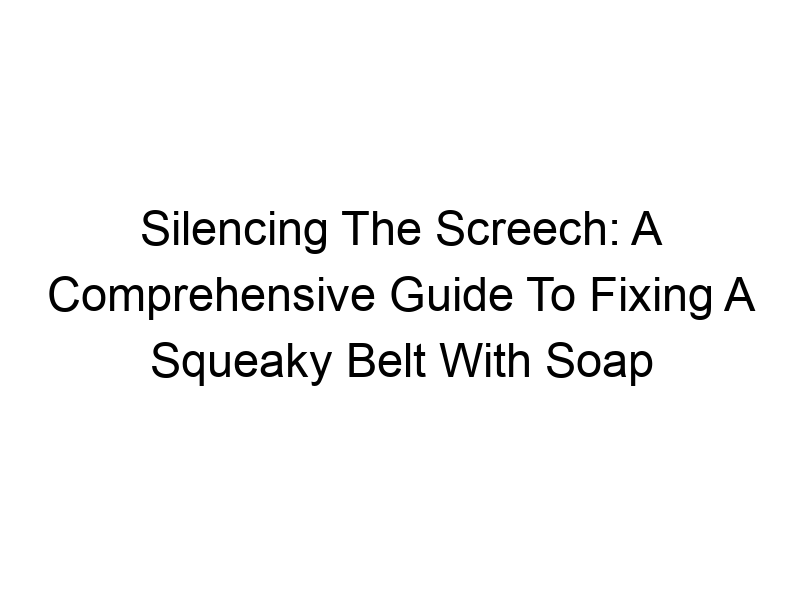A high-pitched squeal coming from your car, lawnmower, or other machine can be incredibly annoying. Often, the culprit is a dry, squeaking belt. While many might reach for expensive sprays, a simple solution is often right at hand: soap. This comprehensive guide will walk you through how to fix a squeaky belt with soap, exploring different types of soap, application methods, and troubleshooting further issues. We’ll cover everything from the basics to more advanced techniques, helping you silence that annoying squeak for good. You’ll learn why this method works, when it’s most effective, and what to do if soap alone doesn’t solve the problem.
A squeaky belt is usually caused by friction. When a belt is dry, its surface loses grip on the pulleys, leading to slippage and the
characteristic squeak. This friction also accelerates wear and tear on the belt itself, potentially shortening its lifespan.
Types of Belts
Different machines use different types of belts, each with its own properties. Understanding the type of belt you’re working with is crucial. Common types include V-belts, serpentine belts, and flat belts. The approach to treating a squeak might vary slightly depending on the belt type, but the basic principles remain the same.
Why Soap Works
Lubrication and Grip
Soap acts as a lubricant, reducing the friction between the belt and pulleys. This temporary lubrication increases grip, preventing the belt from slipping and thus eliminating the squeak. The soap also helps to clean the belt, removing any debris or contaminants that may be contributing to the friction.
Choosing the Right Soap
Not all soaps are created equal. Avoid harsh detergents or cleaners that could damage the belt material. A mild dish soap, bar soap, or even a spray lubricant specifically designed for belts are all good options. The key is to use a lubricant that won’t leave a sticky residue.
Applying Soap to a Squeaking Belt
The Safe and Effective Approach
Safety first! Always turn off and disconnect the power source before working on any machinery. Never attempt to lubricate a running belt. Once the machine is off, use a soft cloth or sponge to carefully apply a small amount of soap to the underside of the belt while it’s still on the pulleys. Avoid excessive amounts; a little goes a long way. For hard-to-reach belts, consider using a spray bottle.
Different Soap Application Techniques
Depending on the belt’s accessibility and the type of soap you’re using, the application method can vary. For instance, a bar of soap can be gently rubbed against the belt’s underside, while liquid soap may be sprayed on with a diluted solution. It’s crucial to ensure even distribution. Using too much soap could lead to issues so always start with a small amount.
When Soap Isn’t Enough
Identifying Deeper Issues
If the squeak persists after applying soap, the problem might be more serious than simple dryness. This could indicate wear and tear on the belt, damage to the pulleys, or even misalignment of the belt system. Inspect the belt for cracks, fraying, or other damage. Check the pulleys for wear or damage as well.
Assessing Pulley Condition
Examine the pulleys for any signs of wear, such as grooves or cracks. Misaligned pulleys can also cause excessive belt slippage and squealing. Ensure the pulleys are properly aligned and not damaged.
Advanced Troubleshooting Techniques
Belt Tension Adjustment
Improper belt tension is a common cause of squeaking. Too tight, and the belt can wear out prematurely. Too loose, and it slips, causing noise. Consult your machine’s manual for the correct tension adjustment procedure. Use the appropriate tools for adjusting tension.
Belt Alignment Check
Ensure the belt is properly aligned with the pulleys. Misalignment can cause uneven wear and premature failure, leading to squeaking. Use a straightedge or alignment tool to verify proper alignment.
Preventing Future Squeaks
Regular Maintenance
Regularly inspecting your belts and pulleys can prevent many issues before they become a problem. A quick visual inspection can identify potential problems early on. This proactive approach can save you time and money in the long run.
Choosing High-Quality Belts
Investing in high-quality belts can make a significant difference in preventing future squeaks. These belts are designed to withstand more wear and tear, extending their lifespan. Check reviews and choose a reputable brand.
Types of Soap for Belt Lubrication
Dish Soap as a Simple Solution
Mild dish soap is a readily available and effective option for lubricating belts. It’s gentle enough to not damage the belt material yet provides sufficient lubrication to reduce friction.
Bar Soap: A Convenient Alternative
Bar soap provides a simple and convenient method for applying lubrication. It’s easy to apply directly to the belt, making it a good option for hard-to-reach areas.
Specialized Belt Dressings
Specialty belt dressings are commercially available and offer superior lubrication and protection. They often contain additives that enhance belt life and prevent premature wear. These dressings provide a more permanent solution than soap alone.
Comparing Different Lubrication Methods
Soap vs. Commercial Sprays
While soap provides a quick and easy fix, commercial belt sprays are designed for more robust and long-lasting lubrication. They typically offer better protection against wear and tear. Consider the frequency of the issue when choosing your method.
Soap vs. Other Home Remedies
Various home remedies, such as WD-40, are often suggested, but these may attract dirt or damage the belt over time. Mild soap is a safer and more effective alternative.
Safety Precautions
Disconnecting Power Sources
Always disconnect the power source before working on any machinery. This prevents accidental injury or damage to the equipment.
Protective Gear
While soap is generally safe, consider wearing gloves to protect your hands from any grease or grime on the belt.
Frequently Asked Questions
What causes a belt to squeak?
A squeaking belt is usually caused by friction between the belt and the pulleys. This friction can stem from a dry belt, worn pulleys, misalignment, or other issues.
Is it safe to use soap on a belt?
Using a mild dish soap or bar soap is generally safe. Avoid harsh chemicals or solvents that can damage the belt. Always turn off and disconnect the machine before applying any lubricant.
How often should I lubricate my belts?
The frequency depends on usage and environment. Regular inspection is key. If you notice the belt becoming dry or the squeak reappearing, it is time for lubrication.
What should I do if soap doesn’t fix the squeaking?
If the squeaking persists, the problem may be more serious, requiring further investigation (e.g., belt wear, pulley damage, alignment issues).
Can I use WD-40 on a belt?
While WD-40 might temporarily silence a squeak, it’s not recommended for long-term use. It can attract dirt and damage the belt over time. A mild soap is a better alternative.
Final Thoughts
Addressing a squeaking belt with soap is a simple, effective, and economical solution for many common issues. This method works exceptionally well for temporary lubrication and cleaning. However, remember that a persistent squeak might indicate a more substantial problem requiring professional attention or replacement of the belt or pulleys. By understanding the root cause, following the right techniques, and prioritizing safety, you can keep your machinery running smoothly and quietly. Remember to regularly inspect your belts for wear and tear and address any issues promptly to avoid more significant problems down the line. By taking proactive steps to maintain your belts, you’ll extend their lifespan and prevent costly repairs.

